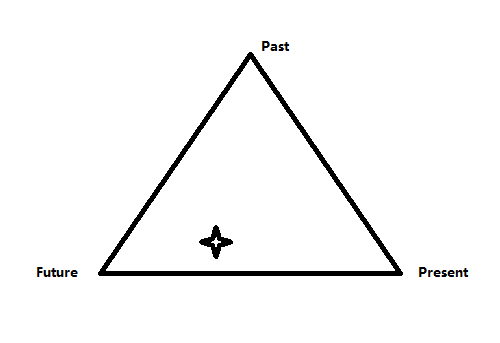End of the Line
It's time to stop thinking in terms of such straight lines between two extremes.
Well, it's alright, everything'll work out fine
Well, it's alright, we're going to the end of the line
We are quite used to thinking of ourselves, and of others, being situated somewhere along linear continuums such as rich to poor, beautiful to ugly, left wing to right wing (politically), timid to aggressive (in character), etc.
It's time to stop thinking in terms of such straight lines between two extremes.
Thinking in Triangles
In business, it often makes a lot more sense to think in terms of triangles, rather than thinking along straight lines. More complex geometry (than triangles) such as quadrilaterals, pentagons, or even myriagons may have been even more useful - were it not for our inability to process large numbers of concepts in our heads simultaneously.
So, triangles it is.
And this is the first in a short series of articles where we will highlight some of these crucial business-triangles.
Triangular Thinking
It is useful to note how prevalent the concept of triangles (or triads) is in other types of (non-business) thinking too. Religion is one such example - although, to be accurate, religion is also big business. There isn't much that isn't business.
The most well-known religious trinities are probably Brahma (creator), Vishnu (preserver) and Shiva (destroyer) in Puranic Hinduism and the Christian trinity of the Father (begets), Son (begotten) and Holy Spirit (proceeds). But, there are many more religious examples such as the Greek triad of Zeus, Athena and Apollo.
We also find scores of examples in the world of fiction where many of the classics such as Rudyard Kipling's "Jungle Books" and L. Frank Baum's "The Wonderful Wizard of Oz" have protagonists that are accompanied by a trinity of companions.
How Triangular-thinking Works
In the cases mentioned in the previous paragraphs, a shared attribute is that each of the corners/vertices of these triangles are bestowed with different sets of talents/gifts/abilities/uses.
And there is then a tension (or a 'pull') in all three of the directions. The protagonist (or worshipper), depending on the situation, continuously has to find a position/location inside of that triangle, or a position towards (or away from) one, two or all three of the corners/vertices.
This type of differentiation-and-pull is our starting point when we will look at these business-focused triangles. The corners are equal. We have to decide where in the triangle we should be located whenever we make decisions.
So, let's discuss one such triangle now. We will highlight a few other triangles in other (future) posts.
Past, Present, Future Triangle
And it's time, time, time
And it's time, time, time, that you love
With Time being our scarcest resource, it makes sense to look at Time first. If we do so by using the concepts of Past, Present and Future at each of the corners/vertices of a triangle, we can immediately have a more nuanced discussion about many types of concepts. We can now position ourselves, our priorities, our roles, our focus, etc. somewhere inside of that triangle (or on one of its lines/edges).

Future does not follow Present and Present does not follow Past in such a triangle. Rather, these now represent disparate focus areas. The selected position inside of that triangle signifies the relative importance (to us, when making decisions) of the concepts to be found at each of the corners.
Solving Business Questions
There are more questions than answers
Pictures in my mind that will not show
If the question that we want to answer is, for example, a visionary-type question, we would probably largely look towards the Future, to a lesser (but probably still significant) extent towards the Past - and probably to a much lesser extent towards the Present. (For Visionary thinking, the Past often has a much greater influence on a likely Future than the Present has, unless events of great significance are now happening in the Present.)
So, in terms of corporate roles, Implementers would be largely concerned with the Present, Visionaries with the Future and Accountants with the Past. Or, if you like, Financial Managers mostly with the Present/Past, Tacticians with the Present/Future, Data Analysts with the Future/Past and Strategists in the center of the triangle.
(Note that the concept of Strategy does not fit in the Future-corner. There is a difference between a great Vision and a great Strategy. Vision is only one element towards a Strategy. Vision informs Strategy. Strategy, during its Diagnosis step, must also diagnose the Past and the Present. This is all covered, in detail, in our book.)
One could debate the above examples (and the accountants would now probably be at the front of that debating queue - even though all three corners really are equal in importance), but it should hopefully now be clear how your thinking processes can be enhanced when you use this type of triangle.
The triangle can help you realise what your blind spots are and guide you towards types of thinking (that may not be natural to you) that will yield much better answers.
Personality profiles
It's just a personality crisis, please don't stop
Because you walk a personality, talk a personality
We covered the 'industry' of performing personality profile assessments in another post. So, here is a wild idea: Let's construct a set of questions towards creating personality profiles in terms of people's natural leanings towards Past, Present, or Future thinking.
Let's construct sets of questions to determine the following: Are you, in your personal stream of consciousness (i.e. in your fluid mental state) primarily future-focused, present-focused, or past-focused? Do you spend hours looking at old photo-albums or discussing last year's beach holiday? Do you live in the moment and make the best of the here-and-now? Or, are you forever looking forward to what is still to come: planning, scheming and thinking.
Would such a personality profile element give you a better idea of where your blind-spots may be? Would it help your manager to apply you better?
If so, we will then seriously think about this being one element of our brand new fully patented cherryflava personality profile assessment technique. Uh, yeah right.
Either way, we will continue playing this game in our subsequent triangle-posts. In the meanwhile, please think about Past, Present and Future in a non-linear manner. Think about Past, Present and Future in triangular terms.
The Bottom Line?
Even though this post advocates for the end of the concept of 'lines' in your thinking, let's have a bottom line.
So, to solve 'this' problem, to answer 'this' question, to make 'this' decision, to choose 'this' strategy, ask yourself: (1) What was/is/will be the impact of the Past, of the Present and of the Future and (2) what will be the impact of our answer then be on the Past, on the Present and on the Future?
True, the above does sound a bit like the joke of the woman who left a note at her front door for the delivery person: "Please don't deliver today. By today I mean tomorrow, because I'm writing this note yesterday."
We'll be back, in future, with more triangles.
Why don't you reconsider, baby?
Give yourself just a little more time

